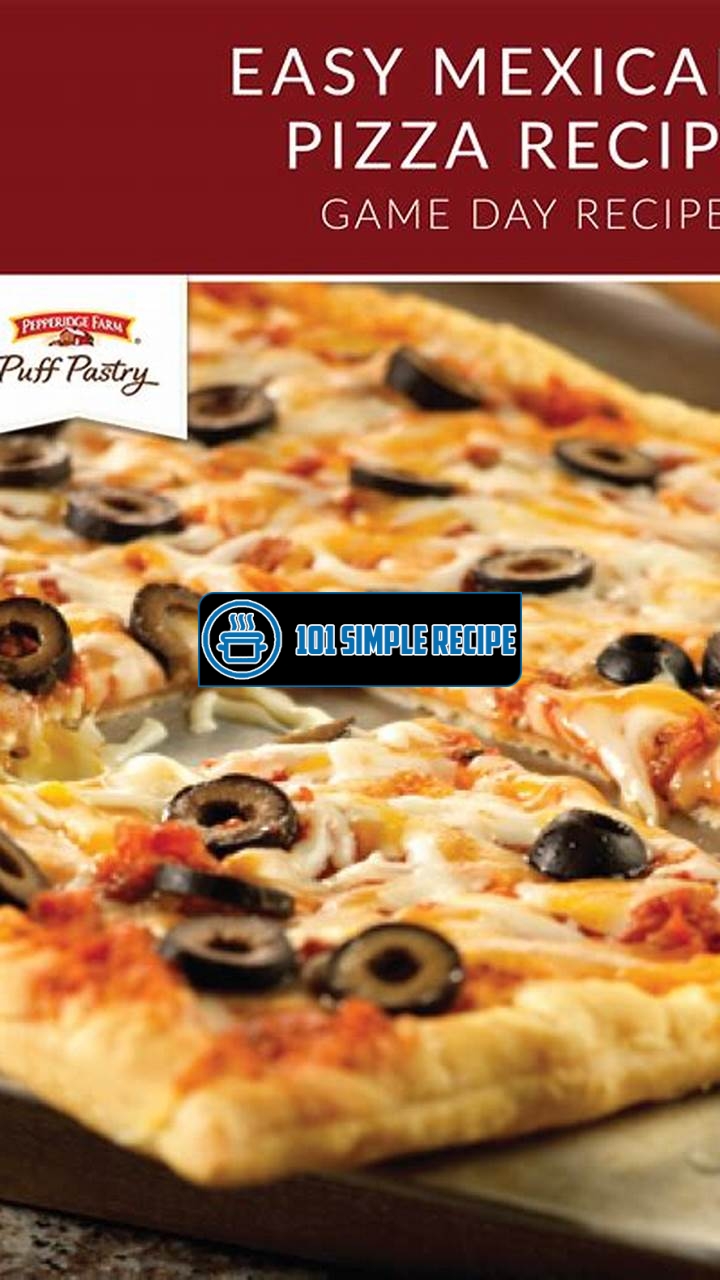Elevate Your Baking Game with Score Puff Pastry!✨ If you’re looking to take your culinary skills to the next level, Score Puff Pastry is here to revolutionize your baking experience. Whether you’re a beginner in the kitchen or an experienced baker, this versatile and oh-so-flaky pastry will effortlessly enhance your creations. Imagine light, buttery layers that practically melt in your mouth, paired with the endless possibilities of sweet and savory fillings.

What is Scored Puff Pastry?
Scored puff pastry is a culinary technique that involves lightly marking the surface of puff pastry before baking. This technique creates decorative patterns and adds an extra layer of texture and visual appeal to your baked goods. By scoring the pastry, you can control the expansion of the dough and create a beautiful finished product.
The Definition of Scored Puff Pastry
Scored puff pastry refers to the process of making shallow cuts or patterns on the surface of the dough before baking. The cuts are typically made using a sharp knife or a dough docker, and they can vary in depth and design. The purpose of scoring is to allow steam to escape during baking, which prevents the pastry from puffing up too much and results in a flaky and evenly risen product.
When you score puff pastry, you create a visual distinction between the layers of dough. This added texture not only enhances the appearance of your pastries but also provides a unique mouthfeel when bitten into. The combination of crisp, flaky layers and the softness of the interior creates a delightful eating experience.
Why is Scoring Important in Puff Pastry?
Scoring is an essential step in working with puff pastry because it serves multiple purposes. Firstly, it allows steam to escape as the pastry bakes. Puff pastry contains a high amount of butter, which creates steam when heated. Without proper scoring, the steam would build up inside the layers, causing the pastry to rise unevenly or even collapse.
Furthermore, scoring helps the pastry to rise evenly and achieve the desired height. By controlling where the puff pastry expands, you can shape it into various forms, such as shells for tarts or rolls for hors d’oeuvres. Scoring also adds an artistic touch to your creations, making them visually appealing and attractive to the eye.
Additionally, scoring is crucial in pastry recipes that call for fillings. The cuts made in the dough provide openings for the filling to expand and prevent it from bursting out or causing the pastry to deform during baking.
Scoring Techniques for Puff Pastry
There are several techniques you can use to score puff pastry effectively:
- Parallel lines: Create straight, parallel lines using a sharp knife or a pastry wheel. This technique works well for creating neat, even patterns.
- Diamond or triangle shapes: Score the pastry in diagonal lines to create diamond shapes or triangles. This technique adds an elegant and decorative touch.
- Crosshatch pattern: Score the pastry in both vertical and horizontal lines to create a crosshatch pattern. This technique produces a more intricate visual effect.
- Custom designs: Let your creativity shine by experimenting with different scoring patterns. You can create swirls, lattice patterns, or even personal monograms.
Remember to score the pastry gently without cutting too deeply. The purpose is to create surface marks without slicing through the layers completely. This way, you can maintain the integrity of the dough while still achieving the desired decorative effect.
In conclusion, scoring puff pastry is an important technique that elevates your baking game. It adds visual interest, controls the rise of the dough, and enhances the overall texture and taste of your creations. With various scoring techniques at your disposal, you can transform simple puff pastry into works of culinary art.
If you’re looking for a delicious pastry recipe, check out this Coca Cola Cake recipe on our site. It’s a classic dessert that’s sure to impress!
The Art of Scoring
When it comes to elevating your puff pastry creations, mastering the art of scoring is essential. Scoring involves creating patterns and designs on the surface of your pastry to enhance both its appearance and texture. These scoring techniques not only add visual appeal but also allow the pastry to rise evenly during baking, resulting in a light and flaky texture.
Simple Scoring Patterns
Simple scoring patterns are a great way to start experimenting with scoring techniques. They are easy to execute and can still make a significant impact on the final look of your pastry. Here are a few simple scoring patterns to try:
- Parallel Lines: Create evenly spaced parallel lines on the surface of your dough using a sharp knife or a scoring tool. This technique is perfect for creating elegant and classic-looking pastries.
- Diamond Pattern: Score diagonal lines in one direction and then cross them with diagonal lines in the opposite direction, creating a diamond-shaped pattern. This pattern adds a touch of sophistication to your puff pastry.
- Checkerboard: Score intersecting parallel lines in one direction and then repeat the pattern in the opposite direction. This creates a checkerboard-like pattern that is visually striking.
Remember to score your puff pastry gently, ensuring you don’t cut all the way through the dough. The goal is to create shallow indentations that guide the pastry’s rising process.
Intricate Scoring Designs
If you’re looking to take your scoring game to the next level, exploring intricate scoring designs is a must. These designs require more skill and precision but can result in stunning and unique puff pastry creations. Here are some ideas to inspire you:
- Floral Patterns: Experiment with scoring techniques that mimic the delicate petals of flowers. You can create overlapping arcs or radiating lines to achieve this effect.
- Geometric Shapes: Use geometric shapes such as triangles, squares, or hexagons to create visually appealing patterns on your puff pastry. Combine different shapes to add complexity to your designs.
- Lettering or Monograms: Personalize your puff pastry by scoring letters or monograms onto the dough. This is a fantastic way to add a special touch to pastries for special occasions.
When attempting intricate scoring designs, it’s crucial to have a steady hand and a sharp scoring tool. Take your time and practice on smaller pieces of pastry before attempting more complex designs.
Choosing the Right Scoring Technique for Your Puff Pastry
With numerous scoring techniques available, it’s essential to choose the right one for your specific puff pastry recipe. Consider the following factors:
Recipe: Different recipes may require different scoring techniques. For example, a recipe that calls for a filling may benefit from a lattice pattern to allow the filling to peek through.
Shape: The shape of your puff pastry can also influence the scoring technique. Circular pastries might look stunning with spiral or radial patterns, while rectangular pastries can be accentuated with diagonal lines.
Occasion: The occasion or theme of your pastry creation can also guide your scoring choices. For festive occasions, consider scoring designs that reflect the holiday or celebration.
Experimenting with different scoring techniques is an exciting way to elevate your baking game. Remember to have fun and let your creativity shine through as you explore the wonderful world of scoring puff pastry. Happy baking!
Enhancing Flavor and Texture
When it comes to baking, achieving the perfect flavor and texture is essential. One technique that can significantly elevate your baked goods is scoring puff pastry. Scoring refers to making shallow cuts on the surface of the dough before baking. This simple step can have a profound impact on the final result, enhancing both the taste and texture of your treats.
The Science Behind Scoring
Scoring puff pastry is not just about aesthetics; there is science behind it. The cuts made during scoring allow the steam generated from the butter within the dough to escape. This process prevents the puff pastry from becoming overly puffy and creates a light, delicate texture. By controlling the release of steam, you can ensure that your baked goods have a consistent rise and texture.
Scoring also helps to prevent the pastry from developing large air pockets, which can cause uneven baking. It allows the heat to penetrate evenly throughout the dough, ensuring that it bakes uniformly. Additionally, scoring helps to prevent the pastry from shrinking excessively during baking, resulting in a more desirable final product.
Creating Layers and Flakiness
One of the key benefits of scoring puff pastry is the creation of layers and flakiness. As the dough bakes, the moisture in the butter converts to steam, creating pockets of air. The scoring cuts help guide the expansion of these pockets, leading to a more pronounced and even rise.
The layers created by scoring also contribute to the flaky texture that is characteristic of well-made puff pastry. As the steam is released through the cuts, the layers separate and expand, resulting in a light, buttery pastry with a satisfying crunch. The combination of airy layers and flakiness enhances the overall eating experience, making your pastries and baked goods simply irresistible.
Adding Visual Appeal through Scoring
Scoring puff pastry not only enhances the flavor and texture but also adds a visually appealing element to your baked goods. The cuts create defined patterns on the surface of the pastry, adding an artistic touch to your creations.
Whether you choose to score in a simple grid pattern or get more creative with decorative designs, scoring allows you to personalize your baked goods and make them visually stunning. The golden-brown crust that forms as a result of scoring further enhances the aesthetic appeal, making your pastries look as good as they taste.
The next time you bake with puff pastry, don’t forget to score it. This simple technique can elevate your baking game, enhancing the flavor and texture of your treats while adding a visually appealing element. Now that you understand the science behind scoring and the benefits it offers, you can confidently incorporate this technique in your baking adventures. Happy baking!
If you’re a fan of puff pastry, you’ll love this Chantilly Cake recipe. It’s a light and fluffy dessert that’s perfect for any occasion.
Scoring for Different Types of Puff Pastry
Discover specific scoring techniques for different types of puff pastry treats.
Scoring Croissants and Danish Pastries
Croissants and Danish pastries are delicate and flaky treats that can be elevated with the right scoring techniques. When scoring croissants, it is essential to create shallow, diagonal cuts on the top surface of the pastry. This not only enhances the appearance but also allows the pastry to expand and rise evenly. You can use a sharp knife or a razor blade to make the cuts.
For Danish pastries, scoring is slightly different. Instead of diagonal cuts, you can create a diamond or crosshatch pattern on the surface. This helps the pastries develop a beautiful texture and adds visual interest. Similar to croissants, make sure the cuts are shallow, allowing the pastry to puff up and achieve the desired lightness.
Remember, scoring is not just about aesthetics; it serves a functional purpose as well. By scoring properly, you allow the steam to escape during baking, preventing the pastries from becoming too doughy or collapsing.
Scoring Puff Pastry Tarts
When it comes to puff pastry tarts, scoring plays an important role in achieving a crisp and golden crust. For rectangular or square tarts, a simple uniform scoring along the border can create a decorative edge. Additionally, pricking the pastry base with a fork can prevent excessive rising and bubbling during baking.
For circular tarts, you can use a sharp knife to create diagonal or crisscross cuts on the surface. This not only adds an elegant touch but also allows the pastry to rise evenly, ensuring a consistent texture throughout.
Don’t be afraid to experiment with different scoring patterns to match the theme or filling of your tarts. For example, a lattice pattern can be created by making parallel cuts on the surface and then weaving thin strips of pastry through them. This adds a visually stunning element to your puff pastry tarts.
Scoring Puff Pastry Pies
Puff pastry pies are a classic dish that can be taken to the next level with strategic scoring techniques. Scoring the top crust of a puff pastry pie allows steam to escape, preventing the filling from becoming soggy and ensuring a crispy crust.
For fruit pies, a lattice pattern is a popular choice. This involves creating even strips of pastry and arranging them in a woven pattern on top of the filling. Apart from being visually appealing, the lattice allows steam to escape and the fruit juices to bubble up, giving the pie a homemade and rustic look.
If you prefer a more straightforward approach, you can also score decorative shapes such as leaves or hearts onto the top crust. This adds a charming touch to your puff pastry pie.
In conclusion, scoring is an essential step in creating puff pastry treats that are not only visually appealing but also have the perfect texture. Experiment with different scoring techniques for croissants, Danish pastries, tarts, and pies to elevate your baking game and impress your guests with your pastry skills!
For a sweet treat, try making these Peanut Butter Cups at home. They’re easy to make and taste amazing!
Perfecting the Scoring Process
Mastering the art of scoring puff pastry can elevate your baking game to a whole new level. Scoring not only adds an attractive aesthetic to your pastries, but it also serves a functional purpose by allowing steam to escape during baking. This results in a light, flaky texture that is the hallmark of a perfectly baked puff pastry.
Scoring puff pastry requires precision and attention to detail. Here are some expert tips and tricks to help you perfect the scoring process:
Tools and Techniques for Scoring
Having the right tools and using the correct techniques are crucial for achieving beautiful and consistent scores on your puff pastry. Here are some essential tools and techniques to consider:
- Sharp knife or pastry cutter: A sharp knife or pastry cutter is essential for creating clean and precise cuts on your puff pastry. Make sure to choose a tool that is comfortable to handle and easy to control.
- Parchment paper or silicone mat: Before scoring your puff pastry, place it on a parchment paper or silicone mat to prevent it from sticking to the work surface. This will make it easier to score and transfer the pastry to the baking sheet.
- Chilled puff pastry: Scoring is easier when the puff pastry is chilled as it reduces the risk of the dough becoming too soft and losing its shape. Ensure your puff pastry is thoroughly chilled before scoring.
- Light pressure: Apply light and even pressure when scoring the pastry. Avoid pressing too hard, as this can compress the layers and affect the puff pastry’s rise during baking.
- Clean cuts: Make sure to use clean, confident cuts when scoring the pastry. This helps create defined edges and prevents the layers from sticking together.
Troubleshooting Common Scoring Mistakes
Even with the right techniques, you may encounter some common scoring mistakes. Here are a few troubleshooting tips to help you overcome these challenges:
Problem: Uneven or jagged cuts. This can happen if your knife isn’t sharp enough or if you’re not applying consistent pressure.
Solution: Ensure your knife is sharp and glide it smoothly and steadily through the dough for clean cuts.
Problem: Dough sticking to the knife. Sticky dough can make scoring difficult and messy.
Solution: Dip your knife in flour or water between cuts to prevent sticking. You can also lightly oil the knife to create a non-stick surface.
Problem: Excessive pressure causing the dough to deform. Applying too much pressure can compress the layers and prevent proper puffing.
Solution: Use a lighter touch and let the sharpness of your knife do the work. Remember, gentle and steady pressure is key.
Experimenting with Scoring for Unique Results
Once you have mastered the basic scoring techniques, don’t be afraid to get creative and experiment with different patterns and designs. Scoring can be a fun way to add your personal touch and create unique results. Here are a few ideas to inspire your creativity:
- Geometric patterns: Create visually appealing patterns by scoring straight lines, triangles, or diamonds. This adds a modern and sophisticated touch to your puff pastry.
- Leaf or petal shapes: Score curved lines or wavy patterns to mimic the shape of leaves or flower petals. This adds an elegant and natural aesthetic to your pastries.
- Creative symbols: Score initials, hearts, or other shapes that hold personal meaning. This adds a personalized touch to your baked creations.
- Layered designs: Score multiple layers at different angles to create intricate patterns and textures. This adds depth and complexity to your puff pastry.
Remember, practice makes perfect. Don’t be discouraged if your first attempts at scoring puff pastry are not flawless. With time and practice, you will develop the skills and confidence to create beautiful and delicious baked treats.
Frequently Asked Questions
Here are some frequently asked questions about Score Puff Pastry:
| No. | Questions | Answers |
|---|---|---|
| 1. | What is Score Puff Pastry? | Score Puff Pastry is a baking technique that involves cutting shallow lines or marks on the surface of puff pastry dough before baking. This technique helps the pastry rise evenly and creates a beautiful, flaky texture that is characteristic of puff pastry. |
| 2. | Why is Score Puff Pastry important? | Scoring puff pastry allows steam to escape during baking, preventing the pastry from puffing up too much and becoming uneven or lopsided. It also creates an attractive pattern on the surface of the pastry, enhancing its visual appeal. |
| 3. | How do I score puff pastry? | To score puff pastry, use a sharp knife or pastry cutter to make shallow cuts on the surface of the dough. You can create straight lines, diagonal lines, or a lattice pattern, depending on your preference or the recipe instructions. |
| 4. | Can I score puff pastry after baking? | No, scoring puff pastry should be done prior to baking. Once the pastry is baked, it becomes flaky and delicate, making it difficult to score without affecting its texture and appearance. |
| 5. | What recipes can I use score puff pastry for? | Score puff pastry can be used in a variety of sweet and savory recipes, such as tarts, pies, turnovers, and palmiers. It adds an elegant touch and enhances the texture of the final baked goods. |
| 6. | Any tips for achieving the best score puff pastry? | Make sure your puff pastry is properly chilled before scoring to prevent it from becoming too soft or sticky. Use a sharp knife and apply gentle, even pressure to create clean cuts. Practice makes perfect, so don’t be discouraged if your first attempt isn’t perfect! |
Closing Thoughts
Thank you for taking the time to read about score puff pastry! We hope you found this article informative and inspiring for your future baking endeavors. Whether you’re a seasoned baker or just starting out, experimenting with score puff pastry can elevate your pastries to a whole new level of deliciousness. Remember to score with confidence and embrace the artistry of baking. Stay tuned for more exciting baking tips and recipes. Happy baking!
Jump to Recipe
Score Puff Pastry

Learn how to create beautifully scored puff pastry that will impress your guests with its flaky texture and visually appealing design.
- 1 sheet of puff pastry
- 1 egg (lightly beaten)
- Preheat the oven to 400°F (200°C) and line a baking sheet with parchment paper.
- Thaw the puff pastry according to package instructions. Roll it out gently on a lightly floured surface to smooth out any creases.
- Using a sharp knife, score the pastry by making shallow cuts in the desired pattern. Be careful not to cut all the way through.
- Lightly brush the scored puff pastry with beaten egg, ensuring an even coating.
- Transfer the scored puff pastry onto the prepared baking sheet and bake for 20-25 minutes, or until golden brown and puffed.
- Remove from the oven and allow to cool slightly before serving. Serve as a standalone pastry or use it as a base for various desserts.






